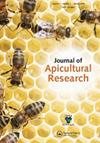Bumble bee nest thermoregulation: a field study
IF 1.8
4区 农林科学
Q2 ENTOMOLOGY
引用次数: 2
Abstract
Abstract Careful control of brood temperature is important for successful colony development in social insects. Six bumble bee colonies of six common Central European species (B. hypnorum, B. hortorum, B. argillaceus, B. pascuorum, B. humilis, B. sylvarum) were continuously monitored for several weeks. We recorded the brood temperature as well as the air temperature in the nest and outside once per minute using a homemade electronic setup. Two colonies succeeded in producing new queens and males during the measurement period while the other four colonies were attacked by parasites at some point during the equilibrium stage. We discuss the nest thermoregulation in view of species and the number of workers in the colony. The results show that the strongest colonies were able to maintain very stable brood temperature over longer periods (standard deviations below 0.5 °C), which is in agreement with previous studies. Colonies with 25 or more workers typically kept the standard deviation below 1 °C. There are two main contributions to the paper. First, we discuss the applicability of a multi-sensor monitoring setup for an outdoor study. Second, due to fast temperature sampling, we were able to observe different thermoregulation strategies that colonies may apply, including keeping the temperature above 31 °C at night and letting it rise during the day in B. argillaceus and short heating cycles in B. sylvarum.大黄蜂巢温度调节:一项实地研究
摘要在群居昆虫中,精心控制孵化温度对群体发育的成功至关重要。对中欧常见的6种大黄蜂(B. hypnorum, B. hortorum, B. argillaceus, B. pascuorum, B. humilis, B. sylvarum)的6个蜂群进行了数周的连续监测。我们使用自制的电子装置每分钟记录一次窝内温度以及巢内和巢外的空气温度。在测量期间,两个蜂群成功产生了新的蜂王和雄蜂,而另外四个蜂群在平衡阶段的某个时候受到了寄生虫的攻击。我们从蚁群的种类和工蜂数量的角度讨论了蚁巢的温度调节。结果表明,最强的菌落能够在较长时间内保持非常稳定的孵化温度(标准偏差低于0.5°C),这与先前的研究一致。有25个或更多工蚁的菌落通常将标准偏差保持在1°C以下。这篇论文有两个主要贡献。首先,我们讨论了多传感器监测装置在户外研究中的适用性。其次,由于快速温度采样,我们能够观察到菌落可能采用的不同温度调节策略,包括B. argillaceus夜间温度保持在31°C以上,白天温度升高,B. sylvarum加热周期短。
本文章由计算机程序翻译,如有差异,请以英文原文为准。
求助全文
约1分钟内获得全文
求助全文
来源期刊
CiteScore
4.80
自引率
10.50%
发文量
111
审稿时长
6-12 weeks
期刊介绍:
The Journal of Apicultural Research is a refereed scientific journal dedicated to bringing the best research on bees. The Journal of Apicultural Research publishes original research articles, original theoretical papers, notes, comments and authoritative reviews on scientific aspects of the biology, ecology, natural history, conservation and culture of all types of bee (superfamily Apoidea).

 求助内容:
求助内容: 应助结果提醒方式:
应助结果提醒方式:


